NIRPS: Near Infra-Red Planet Searcher
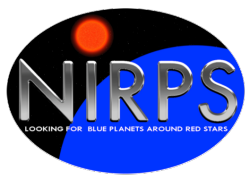
NIRPS is an AO-equipped fibre-fed Y, J and H-band cross-dispersed Echelle spectrograph with a spectral resolution of at least 80’000 that shall routinely deliver radial velocities with a precision of <1 m/s.
Organisation
PI-Institutes:
- Université de Montréal (“UdeM”)
- Université de Genève (“UniGe”), Observatoire Astronomique (English link)
other participating institutions
- Instituto de Astrofísica e Ciências do Espaço (“IA-P”), Porto, Portugal
- Instituto de Astrofísica de Canarias (“IAC”), La Laguna (Tenerife), Spain
- Université de Grenoble – Alpes (“UGA”), Saint-Martin-d'Hères, France
- Universidade Federal do Rio Grande do Norte (“UFRN”), Natal, Brazil
- NRC Herzberg Astronomy and Astrophysics, Victoria, Canada
The project team is composed of:
Principle Investigators:
Project Scientists:
- Étienne Artigau, UdeM, Canada
- Christophe Lovis, Observatoire de Genève, Switzerland
- Xavier Delfosse, IPAG, France
- Pedro Figueira, IA, Portugal
- Bruno Canto, UFRN, Brazil
- Jonay Hernandez, IAC, Spain
Project Management:
- Lison Malo, UdeM, Canada (lison.malo@umontreal.ca)
- Frederique Baron, UdeM, Canada (deputy)
System Engineering:
- François Wildi, Observatoire de Genève, Switzerland
- Nicolas Blind (Front-End), Observatoire de Genève, Switzerland
- Vlad Reshetov (Back-End), NRC, Canada
ESO represented by:
- Project manager and system engineer: Norbert Hubin, ESO, Germany
- Project scientist: Celine Péroux, ESO, Germany
- Project scientist: Gaspare Lo Curto, ESO, Chile
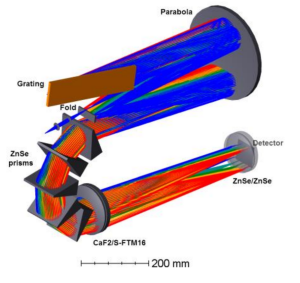
Content
Schedule
Past milestones:
- kick-off: Jan. 2016
- PDR: Nov. 2016
- FDR: May 2017
- Front-End installation, La Silla Nov. 2019
- Back-end PAE: July 2021
- Back-end integration, LaSilla April 2022
- First light May 17th 2022
Current status: Opening to the Community, end of Commissioning
Future milestones:
- PAC (expected 2023)
- FAC
Baseline Speccifications and Performances (as of 20-06-2022)
Performances will be updated after the end of the September 2022 commissioning.
| Subsystem | Parameters |
| HAM mode | Spectral Resolution:𝜆/Δ𝜆=82,000 0.4arcsec object fibre, AO assisted feed 0.4 arcsec sky or simultaneous reference fibre |
| Hem Mode | Spectral Resolution:𝜆/Δ𝜆=75,000 0.9arcsec object fibre, double slicing in the pupil plane 0.4arcsec sky or simultaneous reference fibre |
| Environment | Vacuum: <10-5mbar cryogenic: 80K with 1mk stability |
| Spectral Domain | 0.971-1.854µm (YJH photometric bandpasses) |
| Calibration Sources | Hollow cathode lamp, stabilised Fabry-Perot, Laser frequency comb (starting 2023) |
| Detector and Format | Hawaii 4RG, 4K x 4K, 15µm pixels |
| Limiting Magnitude (AO) | Bright End: H = -0.5 for HE / H = 0.2 for HA Faint End: I = 14.5 |
| Stability | <2m/s intrinsic stability over one night Wavelength Calibration down to <1m/s |
| Sampling | 0.94km/s per pixel, 3.9 pixels per FWHM |
| Operation | Simultaneous operation with HARPS without degrading HARPS performance |
Scientific Objectives
Science case
The main goal of NIRPS is to use the radial velocity method to detect and characterise planets orbiting cool, red, low-mass M-type stars. In particular, NIRPS aims to find Earth-like rocky planets that could potentially be habitable. M-type stars are of particular interest because the radial velocity variations induced by an orbiting planet are larger for a less-massive star than a Sun-like star, and hence their planets — including those in the habitable zone — are more easily detected. NIRPS will operate in the infrared as this is the main range of wavelengths emitted by such small, cool stars. For red stars, which are the most common kind in the solar neighbourhood, NIRPS is expected to produce data that are at least as accurate as currently available with the HARPS instrument.
Similar Instruments:
GIANO at the 3.5m TNG on LaPalma,
CARMENES at the 3.5m Telescope of Calar Alto, Spain,
SPIROU at the 3.6m CFHT on Hawaii,
NIRPS, however, is the only one in the Southern emisphere.
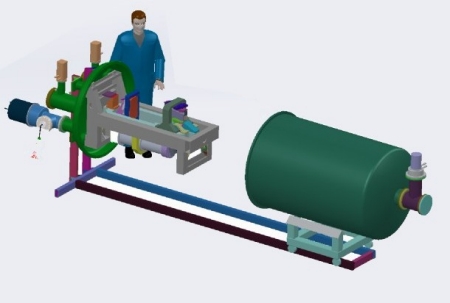
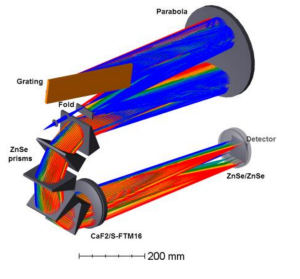
Instrument Description
NIRPS is an infrared extension of HARPS covering instantaneously the Y, J and H band (973.79 to 1808.53 nm). A K-Band extension is possible. NIRPS is a fibre-fed Echelle spectrograph with a spectral resolution of at least 80’000. NIRPS shall routinely deliver radial velocities with a precision of <1 m/s. Beyond this it can also be used as a general purpose spectrograph to observe objects as diverse as Comets or bright AGNs. The total efficiency at blaze peak (including atmosphere, telescope and slit losses for a 1 arcsec seeing in V band) shall be at least of 10%. It will be operated in parallel together with HARPS whereby the NIRPS arm will employ an adaptive optics system to maximize throughput while keeping the instrument size moderate. NIRPS is deployed in two steps:
1. retiring the old HARPS adaptor and replace it with the new one, which includes the AO and the new calibration unit for NIRPS
2. assemblying the NIRPS spectrograph in the 3.6m Coude-lab and commission it thereafter
The HARPS polarimetry will be maintained.
NIRPS will come with a pipeline and all tools to provide science operations and data flow at the ESO/HARPS standard level.
Calibration Unit:
The calibration system is a separate unit that contains all light sources necessary, controllers and injection optics. The Fabry-Perot and the Laser Frequenccy Comb are two independent, standalone units, that will be interfaced with the calibration unit via multimode fibers. The calibration unit is located at the Coude floor and calibration light is transmitted via optical fibers to the NIRPS Front End.
There will be two types of fibres (see below) for the two operations modes of NIRPS (HA, High Accuracy, and HE, High Efficiency).
This unit has its own control module for the various lamps and lasers, power supplies and motors. The whole calibration unit will be fitted into a standard rack and it comprises the following elements:
- 2 fibre-coupled laser diodes at λ1 = 642 nm and λ2 = 1064 nm
- 1 single mode fiber coupled laser diode λ3 = 642 nm
- 2 Uranium-Neon lamps with two fiber outputs each
- 1 Tungsten lamp with two fiber outputs each
- 2 External fiber inputs for the Laser Frequency Comb (to enter operatioins in 2023) and the Fabry-Perot calibration source.
The enclosed figure gives the schematic lay out of the unit.
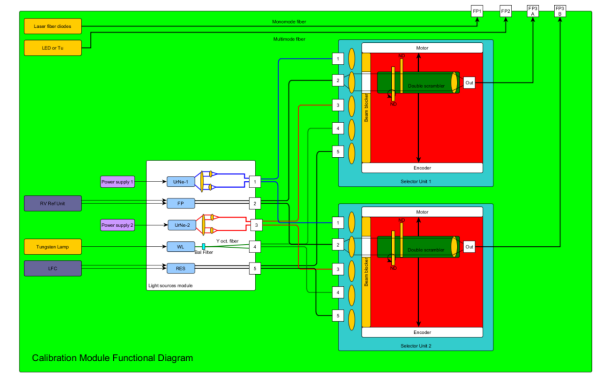
Front End
The front-end comprises everything, which is mounted at the Cassegrain focus of the 3.6m telescope:
- all the HARPS related parts, formerly in the "HARPS adapter", including the HARPS POL;
- the NIRPS adaptive optics module, to improve the coupling efficiency of the fibers feeding the spectrograph;
- an extra port to hook up an optional K-band spectrograph
The schematics of the front end can be seen in this figure:
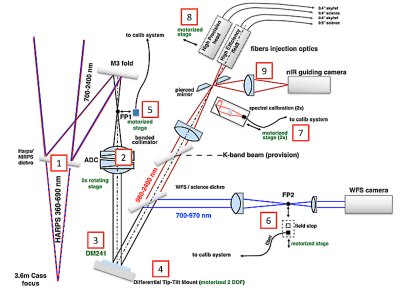
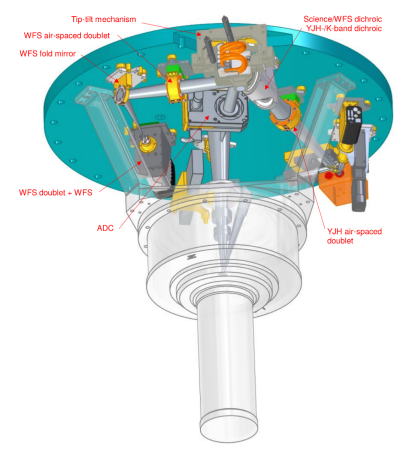
Fiber link
The fiber link connects the "front end" at the Cassegrain focus of the telescope with the "back end", i.e. the specctrograph, located in the East coude room (formerly the CES room). All fibers are octogonal for improved near-field scrambling. Both instrument modes: High Accuracy (HA) and the High Efficiency (HE) use two fibers: one for the science target, and a second one for the reference source (e.g. Fabry-Perot) or the sky (for sky subtractioin in case of faint targets). The sky aperture of the HA fibers is of 0.4", while for the HE fibers is of 0.9" for the science and 0.4" for the sky. Both fiber sets go through optical "double scramblers" that convert near-field to far-field at the entrance of the spectrograph. Moreover the science HA fiber is equipped with a "fiber straetcher" for improved stability for the most demanding High Accuracy mode.
Back End
The backend (spectrograph) design is a standard white pupil, triple pass colliimator, with no moving parts inside, optimized for high efficiency and high stability. Finally the light reaches the 2k x2k HgCdTe detector. Detector mount and read-out system are a spin-off of a near-IR instrument of JWST: Fine Guidance Sensor/Near InfraRed Imager and Slitless Spectrograph (FGS/NIRISS), https://jwst.nasa.gov/fgs.html.
The instrument is packaged into the vacuum vessel:
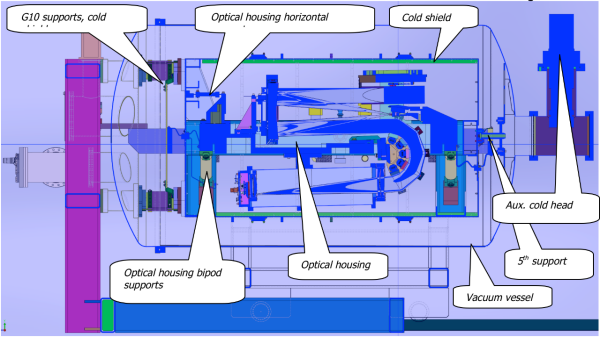
The design has also been chosen to optimize detector coverage. The spectral format and the image quality is shown in the pictures below.
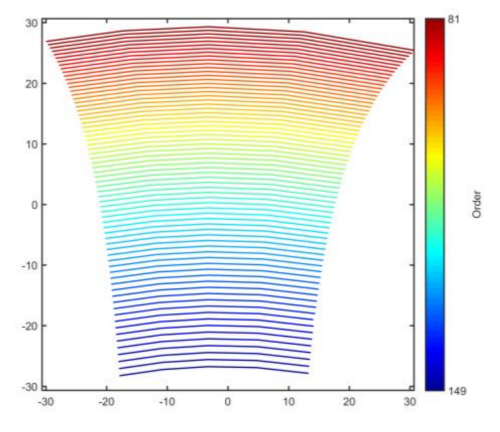
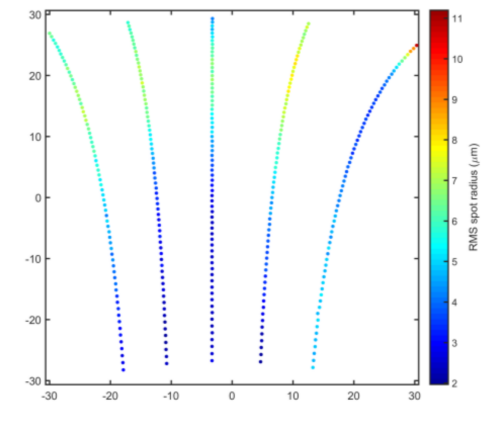
The image quality in the camera is excellent. Compared to a pixel size of 18μm, even in the extreme corners, the image quality is better than a fraction of one pixel, while the spectrum will be slightly over-sampled: the diameter of the HA fibre corresponds to about 3 pixels.
